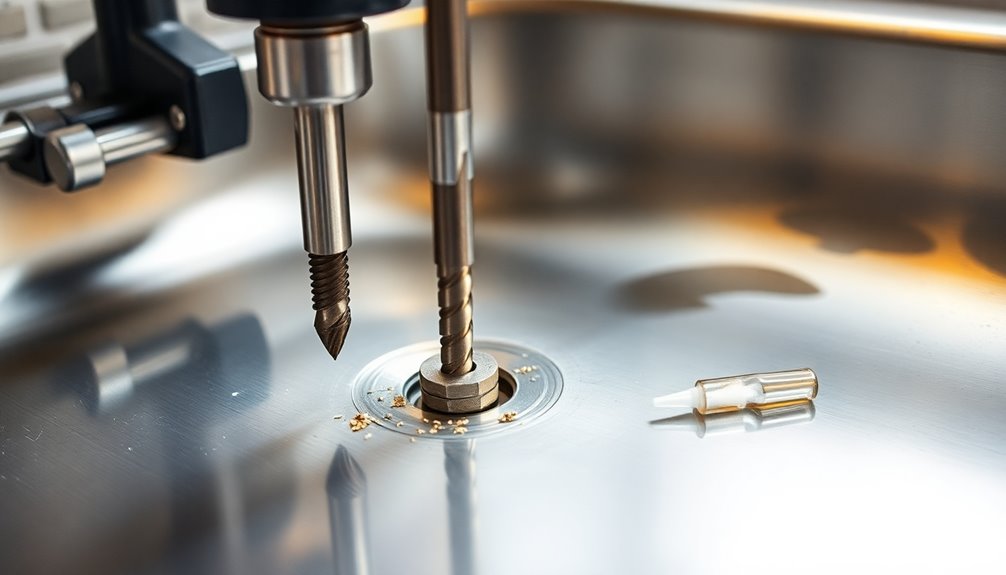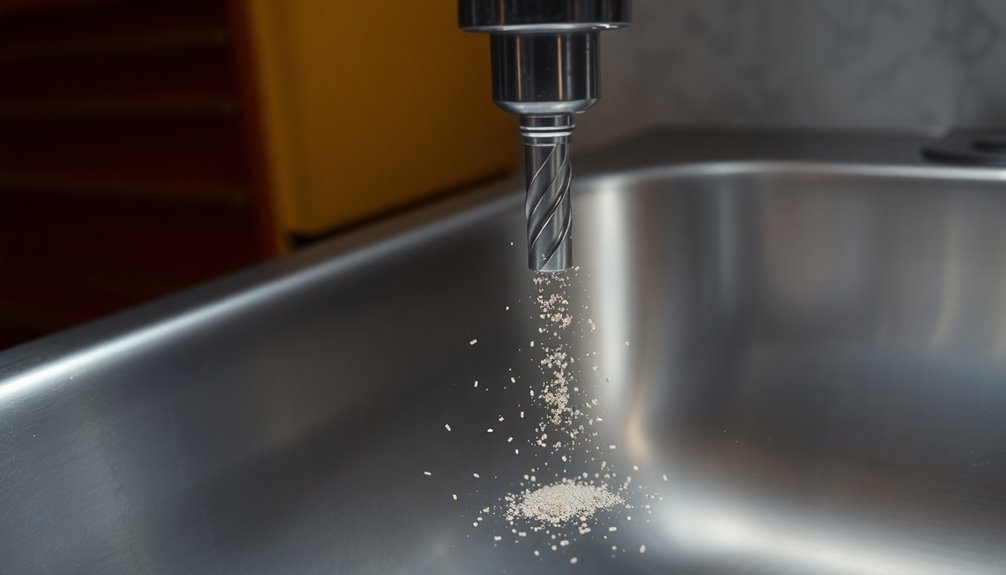To drill a hole in a stainless steel sink, first confirm it's 16 gauge stainless steel and gather tools like a drill and carbide-tipped hole saw. Mark the drilling spot and create a small indentation. Use a cobalt drill bit for a pilot hole, then switch to the hole saw. Apply cutting fluid to reduce friction, and maintain a steady speed. Be sure to take safety precautions, and you'll discover more essential tips for success.
Key Takeaways
- Confirm the sink is made of 16 gauge premium 304 grade stainless steel before drilling.
- Use a cobalt drill bit to create a pilot hole, then switch to a carbide-tipped hole saw.
- Apply cutting fluid to minimize friction and maintain a slow, steady drilling speed.
- Wear safety goggles and gloves for protection, ensuring proper ventilation while drilling.
- Smooth sharp edges with a deburring tool and inspect the hole for irregularities post-drilling.
Preparation Steps for Drilling

Before you start drilling into your stainless steel sink, it's crucial to guarantee you're well-prepared. First, confirm that your sink is made of 16 gauge premium 304 grade stainless steel; this ensures compatibility with your drill.
Gather your tools, including a drill, carbide-tipped hole saw or cobalt drill bits, clamps for securing the sink, and safety gear like goggles and gloves. Mark the drilling location clearly on the sink and create a small indentation to prevent the drill bit from wandering when you start.
Keep your workspace clean and organized to minimize accidents. Finally, place a timber block under the sink lip; this will prevent warping and provide extra support while you drill.
Recommended Drilling Techniques

With your sink securely prepared and your tools at hand, it's time to focus on the techniques that will guarantee a successful drilling process.
Start by using a cobalt drill bit to create a smaller pilot hole; this guides larger bits and maintains accuracy. Next, switch to a carbide-tipped hole saw specifically designed for stainless steel.
Don't forget to apply cutting fluid, like windshield washer fluid, to reduce friction and overheating. Maintain a slow and steady drilling speed, using short bursts to let the drill bit cool down.
Finally, secure the sink firmly and brace the drill to stabilize it. This approach prevents movement, ensuring even holes and avoiding damage to your sink.
Happy drilling!
Safety Measures to Follow

Drilling into a stainless steel sink requires careful attention to safety measures to protect yourself from potential injuries. Always wear safety goggles to shield your eyes from metal shavings. Use heavy-duty gloves to guard against cuts from sharp edges. Proper ventilation is essential, especially when using cutting oils, to avoid inhaling harmful fumes. Keep your hands and body clear of the drill path at all times to prevent accidents. Finally, verify that a first aid kit is readily available to address any minor injuries.
| Safety Measure | Purpose | Tips |
|---|---|---|
| Safety Goggles | Protects eyes from debris | Always wear during drilling |
| Heavy-Duty Gloves | Prevents cuts and abrasions | Choose thick, durable gloves |
| Proper Ventilation | Reduces inhalation of fumes | Work in a well-ventilated area |
| Clear Drill Path | Avoids accidental injuries | Maintain distance from drill |
| First Aid Kit | Addresses minor injuries | Keep nearby during work |
Post-Drilling Care and Finishing

Once you've completed drilling the hole in your stainless steel sink, it's important to focus on post-drilling care and finishing.
Start by using a deburring tool or file to smooth any sharp edges, guaranteeing a clean appearance and preventing injury.
Next, thoroughly clean the area to remove metal shavings and debris, as these can lead to rust or damage over time.
Inspect the drilled hole for irregularities, making adjustments as necessary to ensure a proper fit for your fixtures.
Finally, consider applying a rust inhibitor to the drilled area, especially if your sink's exposed to moisture.
Double-check the alignment and fit of any installed components to guarantee they sit securely in the newly drilled hole.
Troubleshooting Common Issues

While drilling a hole in a stainless steel sink can be straightforward, you might encounter some common issues that require quick solutions.
If your drill bit struggles to penetrate, it's likely dull—replace it with a sharp cobalt or carbide-tipped drill bit for better cutting efficiency.
Notice excessive heat? Reduce the speed and apply cutting fluid to cool the bit and protect both your tool and the sink.
If the drill bit wanders, create a small indentation with a punch tool for guidance.
For fracturing or chipping around the hole edges, switch to a step drill designed for metal to guarantee a cleaner cut.
Finally, if metal shavings obstruct your view, pause periodically to clear them away and maintain a safe workspace.
Frequently Asked Questions
Can I Drill a Hole in a Stainless Steel Sink?
Yes, you can drill a hole in a stainless steel sink.
To do this, you'll need the right tools like carbide-tipped hole saws or cobalt drill bits designed for metal.
Don't forget to use cutting fluid to reduce friction and heat.
Start with a smaller pilot hole to guide the larger bit, and drill at a slow speed to avoid overheating.
Always wear safety goggles and gloves to protect yourself from metal shavings.
What Is the Best Drill Bit for a Stainless Steel Sink?
When you're looking for the best drill bit for stainless steel, you can't go wrong with a carbide-tipped hole saw. It's designed to handle tough materials efficiently.
For pilot holes, consider using cobalt drill bits, as they maintain their sharpness longer.
If you need to enlarge existing holes, a step drill bit works perfectly.
Just remember, regular bi-metal hole saws can be used too, but they require extra care to prevent overheating.
Do You Need a Special Drill Bit for Stainless Steel?
Yes, you need a special drill bit for stainless steel.
Standard bits won't cut it; they often dull too quickly against the tough material. Cobalt drill bits are your best bet, designed to handle high heat and deliver durability.
If you're making larger holes, consider carbide-tipped hole saws for efficiency. Bi-metal hole saws work too, but they'll require lubrication and a bit more effort.
Always choose the right tool for the job!
What Is the Best Tool to Drill Through Stainless Steel?
When you're tackling stainless steel, think of a carbide-tipped hole saw, cobalt drill bits, or a step drill bit.
Each tool excels in its own way: the hole saw cuts through effortlessly, the cobalt bits create smooth pilot holes, and the step drill enlarges existing holes neatly.
If you're looking for precision, a chassis punch delivers clean results.
Remember to use cutting fluid to keep everything cool and efficient while you work!
Conclusion
Drilling a hole in a stainless steel sink may seem intimidating, but with the right prep and techniques, it's a breeze. Just like the shiny surface reflects your effort, the final result showcases your skill. While the roar of the drill might make you nervous, the satisfaction of a clean, precise hole is music to your ears. So, embrace the challenge, and remember that with each step, you're transforming a simple sink into a functional masterpiece.









